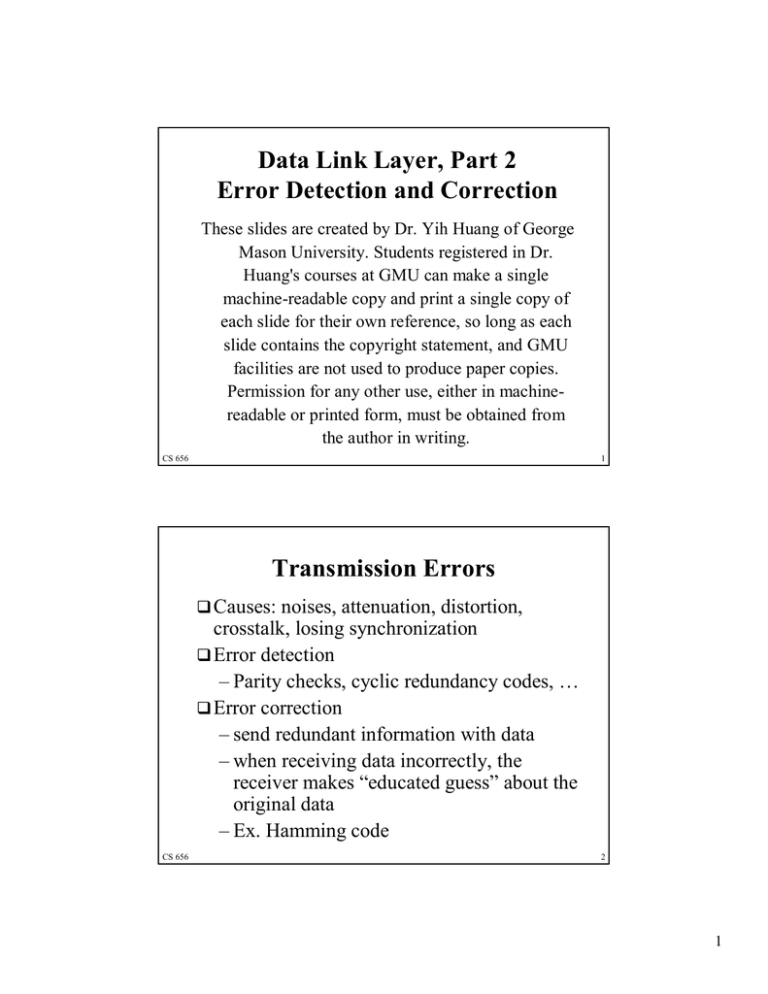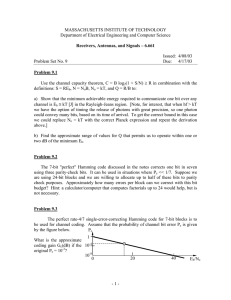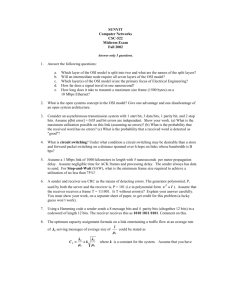Data Link Layer, Part 2 Error Detection and Correction Transmission
advertisement

Data Link Layer, Part 2 Error Detection and Correction These slides are created by Dr. Yih Huang of George Mason University. Students registered in Dr. Huang's courses at GMU can make a single machine-readable copy and print a single copy of each slide for their own reference, so long as each slide contains the copyright statement, and GMU facilities are not used to produce paper copies. Permission for any other use, either in machinereadable or printed form, must be obtained from the author in writing. CS 656 1 Transmission Errors Causes: noises, attenuation, distortion, crosstalk, losing synchronization Error detection – Parity checks, cyclic redundancy codes, … Error correction – send redundant information with data – when receiving data incorrectly, the receiver makes “educated guess” about the original data – Ex. Hamming code CS 656 2 1 Parity Checks Add an extra bit to a string of bits in order to make the total number of 1’s even (even parity) or odd (odd parity) Example (even parity): 0 1 1 0 1 1 0 1 1 Advantages – detects any single bit error – in fact, detects any error involving odd number of bits Disadvantages – only 50% chance of detecting burst errors – an n-bit burst error is a string of bits inverted during transmission CS 656 3 Cyclic Redundancy Codes (CRC) Basic idea: treat string of bits as coefficients of a polynomial that uses modulo 2 arithmetic – Ex. 1 0 1 0 0 1 represents x5 + x3 + 1. Additions and subtractions are equivalent to Exclusive-OR: 1 0 0 1 1 0 1 1 + 1 1 0 0 1 0 1 0 CS 656 1 1 1 1 0 0 0 0 - 1 0 1 0 0 1 1 0 4 2 Method Sender: – divide string (frame) by a generator polynomial G(x) – tag the remainder (called a checksum) onto the frame when it is transmitted Receiver: – divide the entire frame by G(x) – a non-zero remainder indicates errors Example: – data: 1010001101, G(x): 110101 CS 656 1 1 0 1 0 1 5 1 0 1 1 1 0 1 1 1 1 0 1 1 0 1 1 0 0 0 1 1 1 Transmitted data: 101000110101110 CS 656 0 1 1 0 1 0 1 1 1 1 0 1 0 0 0 0 0 1 1 0 1 1 1 1 0 1 0 1 1 0 1 1 1 0 1 1 1 1 0 1 0 1 1 0 1 1 1 0 0 0 0 0 0 1 1 0 1 1 0 0 1 1 1 0 6-bit generator produces 5-bit remainder 6 3 How CRC Works ? D(x): data D’(x): data with appended 0s – Let D’(x) = P(x)G(x) + R(x) T(x): transmitted bits; must be a multiple of G(x) 1 0 1 0 0 0 1 1 0 1 0 0 0 0 0 D’(x) 0 1 1 1 0 R(x) 1 0 1 0 0 0 1 1 0 1 0 1 1 1 0 T(x)=D’(x)-R(x) Suppose the received bits R(x)=T(x), then G(x) also divides R(x). To detect errors, the receiver tests if G(x) | R(x). CS 656 7 When Does CRC Fail ? E(x): error bits Transmitted: 11010101010001111 + Errors: 00001000111000100 Received: 11011101101001011 That is, R(x) = T(x) + E(x) R(x) is accepted by the receiver if G(x)|R(x) Hence, what is the relationship between G(x) and E(x) to cause the CRC to fail ? CS 656 8 4 Example of a CRC Failure From the earlier example: – G(x) = x5 + x4 + x2 + 1 (110101) – D(x): 1 0 1 0 0 0 1 1 0 1 – T(x): 1 0 1 0 0 0 1 1 0 1 0 1 1 1 0 – E(x): 1 1 1 1 – R(x): 1 0 1 0 0 0 1 0 1 0 0 1 1 1 1 – Please check that E(x)=G(x)*(x2+1) – You can check for yourself that R(x) will be (incorrectly) accepted by the receiver. CS 656 9 Generators Are Not Born Equal If G(x) contains two or more terms, then it can detect all single bit errors. – Why? CS 656 10 5 detects all double errors if – x does not divide G(x), and – G(x) does not divide xk + 1 for any k < K where K is the frame length Why? CS 656 11 detects all odd errors if G(x) contains x + 1 as a factor. Why? CS 656 12 6 Other CRC Properties If G(x) satisfies all the above properties, then – all burst errors of length r or less are detected, where r is the degree of G(x), – burst errors of length r + 1 are missed with probability 1 2r −1 – burst errors of length r + 2 or more are missed with probability 1 2r CS 656 13 Common Generators CRC-8: x8 + x2 + x + 1 (used with ATM) CRC-CCITT: x16 + x12 + x5 + 1 (used with HDLC) – catch all single, double, and odd errors – catch all burst errors of length of 16 or less – catch 99.997% of burst errors of length 17 – catch 99.998% of length 18 or more CRC –32: x32 + x26 + x23 + x22 + x16 + x12 + x11 + x10 + x8 + x7 + x5 + x4 + x2 + x + 1 (used with Ethernet) CS 656 14 7 Error Correcting Codes Frame consists of m data bits and r check bits. The resulting n = m +r bit unit is called a codeword. The number of bits by which two codewords differ is called the Hamming Distance. To detect d-bit errors, we need distance of d + 1 between any pair of codewords. – codewords with single parity bit have a minimum distance of 2 To correct d-bit errors, we need distance of 2d + 1. CS 656 15 An Example Consider a (inefficient) coding scheme where each bit is simply repeated three times. 000 001 010 011 100 101 110 111 000 000 000 000 111 111 111 111 000 000 111 111 000 000 111 111 000 111 000 111 000 111 000 111 The minimum Hamming distance among the above codewords is 3. This scheme can detect any 2-bit errors. CS 656 16 8 A Naïve Error Correction Method The above scheme can also be used to correct 1-bit errors. When receiving an invalid codeword, we assume that the original data is the closest, valid codeword. 100 000 000 100 000 111 010 000 000 001 000 000 000 000 110 000 000 001 000 000 010 000 000 000 000 100 000 000 000 101 000 000 100 000 010 000 010 000 111 000 000 011 000 001 000 001 000 111 000 000 111 000 001 111 000 100 111 000 010 111 CS 656 17 To Correct 1-Bit Errors each of the 2m legal codewords must have n + 1 bit patterns dedicated to it. that is, (n + 1)2m < = 2n divide both sides by 2m to obtain ( m + r + 1) ≤ 2 r Examples: – 11 data bits, how many check bits ? – 16 data bits, how many check bits ? – 32 data bits, how many check bits ? CS 656 18 9 Hamming Codes Achieves the theoretical lower bound of check bits. number bits 1 to n power-of-2 positions are check bits the value of each check bit 2k depends on the parity of the bits whose label contains that 2k when written as the sum of powers of 2. to find out the incorrect bit, determine if check bits are correct add 2k to a counter c if the check bit is one of the wrong parity. in the end, if c = 0, then it gives the position of the incorrect bit. CS 656 19 Example original data: 1 0 1 0 1 1 0 codeword: 0 1 1 1 0 1 0 0 1 1 0 bit numbers: 1 2 3 4 5 6 7 8 9 10 11 0001 1 0010 2 0011 3 0100 4 0101 5 0110 6 0111 7 1000 8 1001 9 1010 10 1011 11 CS 656 20 10 Error Correction in Action Error received: 0 1 1 1 1 1 0 0 1 1 0 bit numbers: 1 2 3 4 5 6 7 8 9 10 11 Parity checks: 20 = 1, fail 21 = 2, pass 22 = 4, fail 23 = 8, pass Denote pass by 0 and fail by 1. We have: 0 1 0 1 = 5 23 22 21 20 CS 656 21 Discussion In a nutshell, error correction technologies are educated guests on the part of the receiver. Error corrections are typically used by applications that – can tolerate occasional errors – but cannot tolerate the delays of data retransmissions Example: multimedia playback CS 656 22 11



